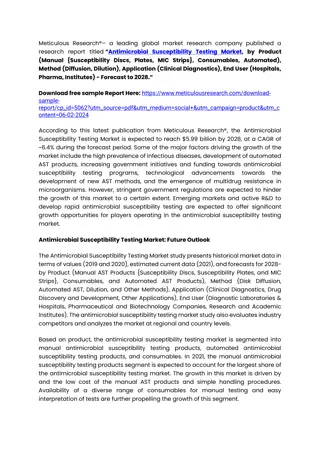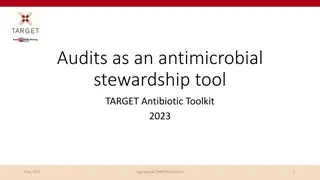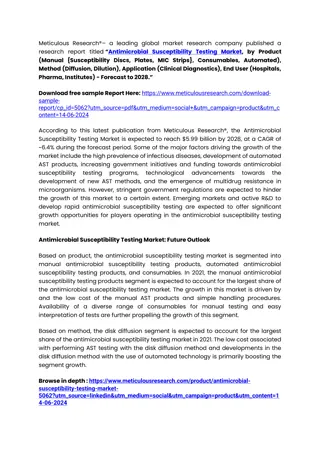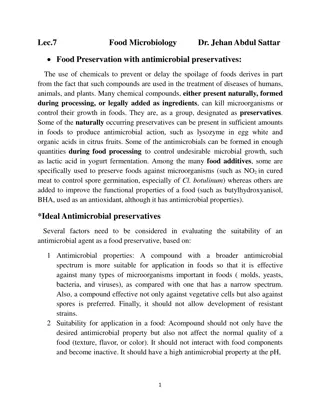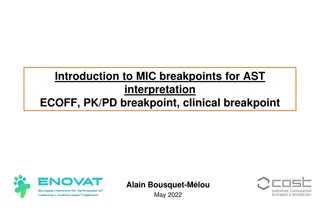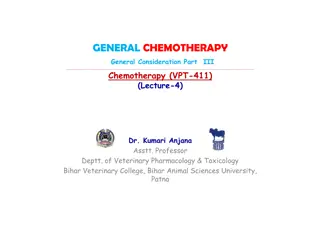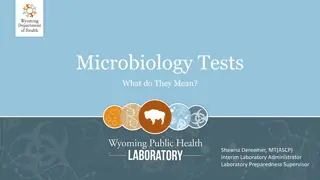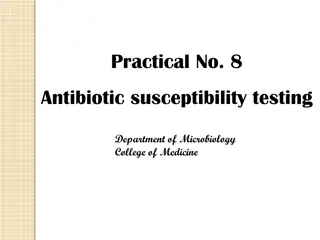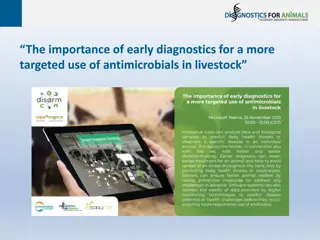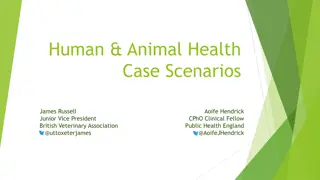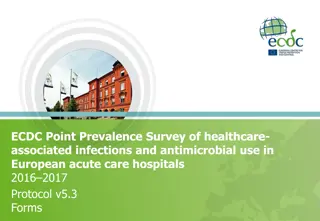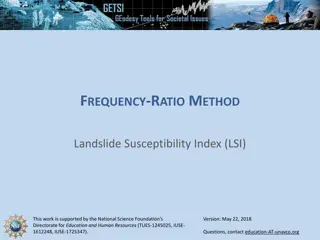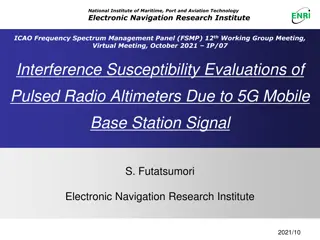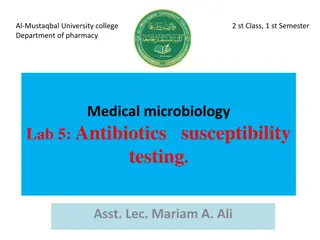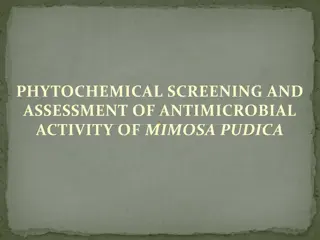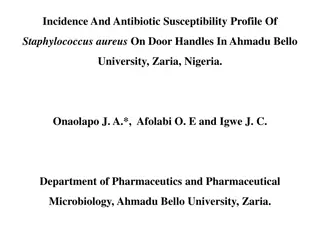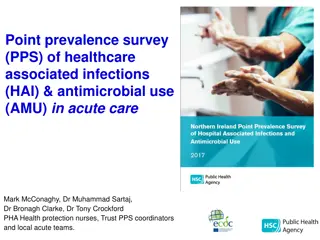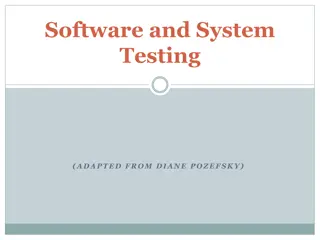Peptic Ulcer Disease: Treatment Approaches and Helicobacter pylori Eradication
Common gastrointestinal conditions such as peptic ulcers can be effectively treated through approaches like eradicating H. pylori infection, reducing gastric acid secretion, and using mucosal protecting agents. Helicobacter pylori eradication is crucial for healing ulcers and preventing recurrence,
0 views • 27 slides
Antimicrobial Susceptibility Testing Market
Antimicrobial susceptibility testing (AST) is a laboratory procedure to identify the right antimicrobial regimen against microbes. Thus, AST of the causative agent(s) is essential for the timely selection of appropriate antimicrobial therapy.
2 views • 3 slides
Utilizing Audits for Antimicrobial Stewardship in General Practice
The importance of audits in antimicrobial stewardship is highlighted in this informative content covering topics like why audit and feedback are crucial, sources of prescribing data, available audit tools, practical tips, and a case study showcasing the positive impact of audits in UTI management. T
10 views • 40 slides
Antimicrobial Coatings Market: Exploring Sustainable Approaches to Microbial Con
The Antimicrobial Coatings Market is projected to reach $12.41 billion by 2031, at a CAGR of 10.8% from 2024 to 2031. The antimicrobial coatings help to keep surfaces pathogen-free by obstructing the growth of fungi, bacteria, and other parasites. Antimicrobial coatings provide long-lasting protecti
3 views • 4 slides
Antimicrobial Susceptibility Testing Market
Government initiatives for combating multidrug resistance are expected to boost the need for antimicrobial susceptibility testing products, thereby driving the growth of the global antimicrobial susceptibility testing market.
1 views • 2 slides
Food Preservation with Antimicrobial Preservatives
Food preservation with antimicrobial preservatives involves the use of chemical compounds to prevent or delay food spoilage. These compounds, either naturally present or added during processing, can kill microorganisms or control their growth in foods. Factors for evaluating the suitability of an an
6 views • 8 slides
Understanding Antibiotic Susceptibility Testing Methods
Antibiotic susceptibility testing is crucial for determining effective antibiotics against bacterial infections. Common methods include Kirby-Bauer and agar disk diffusion, evaluating zones of inhibition to categorize susceptibility. Techniques involve seeding agar plates, placing antibiotic disks,
2 views • 17 slides
Understanding MIC Breakpoints in Antibiotic Susceptibility Testing
Antibiotic susceptibility testing evaluates bacteria's response to antibiotics, aiding prescribers in drug selection by determining resistance levels. The interpretation involves categorizing results into S/I/R based on MIC breakpoints and growth inhibition zones. MIC values, ECOFF, PK/PD cutoffs, a
0 views • 21 slides
Understanding Software Testing Metrics and Tools
Software testing metrics play a crucial role in evaluating the quality and progress of the testing process. Metrics provide valuable insights into the readiness, quality, and completeness of a product. By measuring attributes such as defects, testing efficiency, and productivity, organizations can m
3 views • 100 slides
Fundamentals of Software Testing Explained
Software testing is a critical process to ensure that software applications meet requirements and are free of defects. It involves various activities such as test planning, analysis, design, implementation, and execution. Testing approaches like the Bing bang approach and Total Quality Management ar
1 views • 48 slides
Ideal Antimicrobial Agents and Antimicrobial Classification Overview
This lecture on general chemotherapy outlines the properties of ideal antimicrobial agents, emphasizing selective and effective activity, bactericidal action, non-toxicity, and more. It also covers the classification of antimicrobials based on chemical structure, including sulfonamides, diaminopyrim
6 views • 19 slides
Understanding Microbiology Testing Methods and Results
Explore the various methods of microbiology testing, learn to interpret microbiological test results, and understand antibiotic susceptibility testing. Discover details on bacterial, viral, and parasitic infections through laboratory reports and supporting results like WBC counts and pathogen identi
0 views • 29 slides
Understanding Antibiotic Susceptibility Testing
Antibiotic susceptibility testing is crucial in determining the effectiveness of antibiotics against specific bacteria. The Kirby-Bauer method, a standardized paper disk agar diffusion method, is commonly used for this purpose. By observing zones of inhibition around antibiotic disks on agar plates,
1 views • 21 slides
Understanding Equivalence Class Testing and Its Application in Software Testing
Equivalence class testing is a software testing technique that involves dividing input values into classes for effective testing coverage. Equivalence classes are defined mathematically as subsets of a given set, ensuring partitioning and mutual exclusivity. By applying equivalence partitioning, tes
1 views • 21 slides
Uganda's Successes in Reaching Men with HIV Testing Through Assisted Partner Notification Program
Uganda has successfully implemented an Assisted Partner Notification (APN) program to reach men for HIV testing, addressing the gender gap in testing rates. By utilizing various approaches such as index testing, self-testing, and social network testing, Uganda has achieved significant success in tar
0 views • 12 slides
Overview of Epidemiological Cutoff Values (ECVs) in Antimicrobial Susceptibility Testing
Epidemiological Cutoff Values (ECVs) are crucial in determining antimicrobial susceptibility by distinguishing wild-type and non-wild-type microbial populations. ECVs are defined based on factors like minimal inhibitory concentration (MIC) and genetic variation, and are determined through specific m
0 views • 16 slides
Advances in Antimicrobial Drugs: Selective Toxicity and Classification
The development of antimicrobial drugs has significantly improved therapeutics by controlling infections and preventing complications. These drugs target invading microorganisms using selective toxicity, sparing host cells. Antimicrobial drugs are classified based on site, mechanism of action, and c
0 views • 30 slides
Enhancing Livestock Health Through Early Diagnostics and Targeted Antimicrobial Use
Utilizing early diagnostics in livestock for targeted antimicrobial administration is essential for effective disease management and reducing antimicrobial resistance. This approach aids in timely treatment, facilitates monitoring of animal health status, and supports preventive measures against eme
0 views • 10 slides
Understanding Antimicrobial Stewardship in Healthcare
Exploring the critical aspects of antimicrobial stewardship, including the reasons for antibiotic resistance, considerations for prescribing antibiotics, stewardship checklists, and the role of toolkits in promoting responsible antibiotic use to combat resistance. The importance of monitoring, docum
0 views • 20 slides
Software Testing Foundation Level: Testing Throughout the SDLC Quiz
Explore key concepts in software testing throughout the Software Development Lifecycle (SDLC) with a quiz covering topics like white-box testing in acceptance testing, component testing vs. system testing, and regression testing purposes. Enhance your understanding of testing methodologies with samp
5 views • 17 slides
Importance of Software Testing in Preventing Catastrophic Failures
Software testing is crucial in ensuring the reliability and safety of software systems, as highlighted by catastrophic failures such as the Ariane 5 rocket incident and the Therac-25 radiation therapy machine disasters. These examples underscore the importance of thorough testing in identifying and
1 views • 42 slides
ECDC Point Prevalence Survey of Healthcare-associated Infections and Antimicrobial Use in European Acute Care Hospitals 2016-2017 Protocol v5.3 Forms
This protocol outlines the data collection form for the ECDC Point Prevalence Survey focusing on healthcare-associated infections and antimicrobial use in European acute care hospitals during 2016-2017. The detailed form covers various aspects such as hospital information, infection control measures
0 views • 8 slides
Testing Approach in SCREAM for E3SM Fall All-Hands 2019
Major effort is focused on verification and testing in SCREAM for the E3SM Fall All-Hands. The initiative includes unit testing, property testing, regression testing, and leveraging various tools like Cmake, Python, Jenkins, AutoTester, and GitHub for Continuous Integration (CI). The emphasis is on
1 views • 21 slides
Understanding Landslide Susceptibility Using Frequency-Ratio Method
This informative content delves into the Frequency-Ratio Method for Landslide Susceptibility Index (LSI), supported by the National Science Foundation. It explains how Frequency-Ratio (FR) methods are used for analyzing landslide susceptibility, the mathematical calculations involved in determining
0 views • 15 slides
Evolution of Antimicrobial Susceptibility Testing in Veterinary Medicine
Antimicrobial Susceptibility Testing (AST) in veterinary medicine has transitioned from limited usage to targeted therapy with species-specific clinical breakpoints. Current challenges include low testing frequency and the need for more reliable, rapid, and cost-effective testing methods. Incentives
0 views • 32 slides
Interference Susceptibility Evaluations of Pulsed Radio Altimeters Due to 5G Signal
This document presents the results of interference susceptibility testing of two pulsed radio altimeters in the presence of 5G mobile base station signals. The test parameters, setup, and results are detailed, including in-band and out-band interference evaluations. The objective is to assess the re
0 views • 16 slides
Understanding Antibiotic Susceptibility Testing in Medical Microbiology Lab
Antibiotics are chemical substances produced by microorganisms to inhibit or kill other microorganisms. In the lab, antibiotics susceptibility testing is conducted using the Disc Diffusion method (Kirby-Bauer method) on agar plates. The sensitivity of bacteria to antibiotics is determined by measuri
0 views • 11 slides
Understanding Antimicrobial Stewardship: Key Concepts and Importance
Explore the critical aspects of Antimicrobial Stewardship, including its definition, historical background, and the impact of antimicrobial resistance. Learn about the basics, such as the relationship between antimicrobial use and resistance patterns, as well as the importance of optimizing antimicr
0 views • 61 slides
Optimised Live/Dead Fluorescence Spectrometry for Antimicrobial Susceptibility Testing
This study focuses on the optimisation of live/dead fluorescence spectrometry for rapid antimicrobial susceptibility testing. The research uses fluorescent dyes to distinguish between live and dead cells, providing a potential method for quick antimicrobial resistance diagnostics. The experiment inv
0 views • 16 slides
Complexities of Antimicrobial Resistance in Farm Animals and Public Health
The epidemiology of antimicrobial resistance is multifaceted, involving various sectors such as aquaculture, soil, wildlife, human-animal interfaces, and more. The case study on ceftiofur resistance in chickens highlights the impact of antibiotic use on resistance levels in both animals and humans.
0 views • 4 slides
Understanding Testing in Software Engineering
In the previous session, we discussed various aspects of software engineering, including modeling with UML diagrams, such as activity diagrams, use case diagrams, sequence diagrams, state diagrams, and class diagrams, as well as architecture patterns. Testing was emphasized as a key aspect, highligh
0 views • 35 slides
Understanding Gray Box Testing in Software Development
Gray Box Testing is a software testing technique that involves testing the software with partial knowledge of its internal workings. It combines aspects of White Box Testing and Black Box Testing, allowing testers to check both the presentation layer and the code part of an application. Gray Box Tes
0 views • 14 slides
Phytochemical Screening and Antimicrobial Assessment of Mimosa pudica
This study explores the antimicrobial potential of Mimosa pudica extracts through phytochemical screening. Researchers investigated the leaves' antimicrobial characteristics and screened for phytochemical compositions to understand their effects on various microorganisms. The methodology involved sa
0 views • 18 slides
Challenges in Prescribing the Right Antimicrobial Agents
Prescribing the appropriate antimicrobial medication can be a daunting task due to various factors. In this case discussion, the patient is on multiple medications for different conditions, making it essential to carefully consider the choice of antimicrobial. Factors such as drug interactions, pati
0 views • 30 slides
Incidence and Antibiotic Susceptibility of Staphylococcus aureus on Door Handles in Ahmadu Bello University
Environmental microorganisms, like Staphylococcus aureus, play a significant role in morbidity and mortality. This study explores the incidence and antibiotic susceptibility profile of Staphylococcus aureus isolated from door handles in Ahmadu Bello University, Zaria, Nigeria. The research aims to a
0 views • 22 slides
Guidelines for HIV Testing During Pregnancy and Postpartum
These guidelines recommend HIV testing during pregnancy, at delivery, and postpartum. Testing should be done early in pregnancy and again in the third trimester. Expedited testing during labor is required for certain patients, and syphilis testing is recommended. Pre-exposure and post-exposure proph
0 views • 18 slides
Understanding Unit Testing in Software Engineering
Concept Software is a discipline comprising various code pieces. Testing these codes together is complex but vital in Software Engineering. The process includes early testing like unit tests, pairwise/multiple component testing, module testing, integration testing, user tests, alpha tests, beta test
1 views • 6 slides
Insights into Healthcare-Associated Infections and Antimicrobial Use in Acute Care Settings
This report presents findings from a Point Prevalence Survey (PPS) on Healthcare-Associated Infections (HAI) and Antimicrobial Use (AMU) in acute care, highlighting the prevalence rates, distribution of infections, changes in infection rates, and patterns of antimicrobial consumption across European
0 views • 17 slides
Importance of Software and System Testing
Understanding the critical role of software and system testing in identifying and fixing errors before they lead to major failures. Various types of testing such as functional, usability, performance, and reliability testing are essential to ensure the quality of software products. Different classif
0 views • 52 slides
Managing Catheter-Related Bloodstream Infections in Vascular Access
Reduce and prevent catheter-related bloodstream infections in vascular access by addressing extraluminal infection sources and implementing strategies outlined in national drivers such as the NHS Long Term Plan and the Antimicrobial Resistance Action Plan. Recognize the importance of tackling antimi
0 views • 25 slides

